The Eccentric Dr. Nakamats
The Inventor Series > Dr. Nakamats > Thanko > Maywa Denki
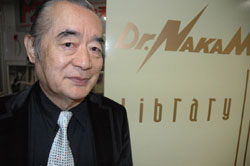 A proclivity for inventiveness is one of the Captain's trademarks. Though admittedly this usually amounts to his slick adoption of aliases that allow for multiple "bottle keep" privileges at his favorite Kabukicho hostess clubs.
A proclivity for inventiveness is one of the Captain's trademarks. Though admittedly this usually amounts to his slick adoption of aliases that allow for multiple "bottle keep" privileges at his favorite Kabukicho hostess clubs.
But likely the newsman is no match for Japan's wackiest inventor, Dr. Nakamats. Join him this week as he clashes test tubes with Nakamats at his famed Dr. Nakamats House in Tokyo.
The declining birthrate is a well-known issue in Japan, but for renowned inventor Dr. Yoshiro Nakamatsu, it is merely another challenge. Two weeks ago at a press conference in Tokyo, Nakamats, who prefers to drop the "u" from his name, unveiled a new bottle of Love Jet, a product first introduced nearly two decades ago that is said to boost a woman's level of the hormone dehydroepiandrosterone when applied to her private parts.
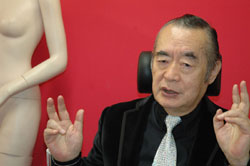 Seated behind his cluttered desk in Dr. Nakamats House, located in the upscale Shimouma neighborhood of Tokyo's Setagaya Ward, the inventor is very proud of the new version. "It has a dispenser that is smaller, making it perfect for her handbag. After a woman sprays Love Jet, men will flock around her," explains Nakamats earnestly, sharply dressed in a sparkling silver tie, velvet coat and gray trousers.
Seated behind his cluttered desk in Dr. Nakamats House, located in the upscale Shimouma neighborhood of Tokyo's Setagaya Ward, the inventor is very proud of the new version. "It has a dispenser that is smaller, making it perfect for her handbag. After a woman sprays Love Jet, men will flock around her," explains Nakamats earnestly, sharply dressed in a sparkling silver tie, velvet coat and gray trousers.
In addition to the seemingly magical properties within this liquid of lust, Nakamats, whose 3,000-plus inventions include work on the floppy disk and automatic pachinko machine, adds that the 4,000-yen item also comes with a triangle-shaped template with adhesive that assists a lady in trimming any pubic hair that might otherwise poke from the edges of her panties.
"Women always want to have a beautiful body and skin," he says, his thick gray eyebrows not twitching a bit as he speaks. "This product makes them feel beautiful inside and out."
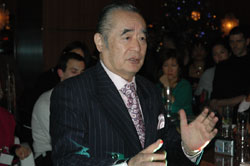 Certainly many questions could be raised about the efficacy of such a concept in upping Japan's birth total. Yet the eccentric Nakamats has parlayed this type of over-the-top showmanship into an intriguing career that has garnered the 79-year-old a worldwide reputation for innovation.
Certainly many questions could be raised about the efficacy of such a concept in upping Japan's birth total. Yet the eccentric Nakamats has parlayed this type of over-the-top showmanship into an intriguing career that has garnered the 79-year-old a worldwide reputation for innovation.
His design process comprises three elements: a theory, a practical aspect, and inspiration — the latter of which Nakamats insists is triggered by a flash of thought that eventually develops into the actual invention.
"If something does not have these three elements, then it is not an invention," he says, in very decent English. "Ideas are based on new principles or theories that have never been considered by other scientists. But they alone are not inventions. An invention achieves the highest level, where the benefit should be for everybody. Usually people invent for love of money. I do it for love."
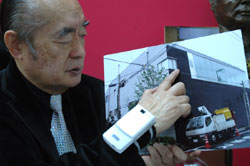 Dr. Nakamats House, completed in 2005, represents the love the inventor has for the earth. With its distinctive floppy-disk-shaped front door, the four-story concrete building is powered, Nakamats claims, by "cosmic energy," whose source is charged particles (such as the nuclei of atoms) arriving from outer space in rays at roughly the speed of light. A black "antenna" that covers most of one exterior wall collects this energy and distributes it to a converter that then produces enough electricity to power the entire facility and its roughly 30 guest rooms, which Nakamats says are used by scientific luminaries from around the world who congregate to share new ideas. Nakamats even boasts that his system is so prolific that he actually winds up selling excess electricity to Tokyo Electric Power Co. (TEPCO).
Dr. Nakamats House, completed in 2005, represents the love the inventor has for the earth. With its distinctive floppy-disk-shaped front door, the four-story concrete building is powered, Nakamats claims, by "cosmic energy," whose source is charged particles (such as the nuclei of atoms) arriving from outer space in rays at roughly the speed of light. A black "antenna" that covers most of one exterior wall collects this energy and distributes it to a converter that then produces enough electricity to power the entire facility and its roughly 30 guest rooms, which Nakamats says are used by scientific luminaries from around the world who congregate to share new ideas. Nakamats even boasts that his system is so prolific that he actually winds up selling excess electricity to Tokyo Electric Power Co. (TEPCO).
Since Nakamats considers a building's columns to be a weak point during earthquakes, his structure has been specially designed without them. Further, the walls and support beams have been poured with concrete made from cement that is another Nakamats invention.
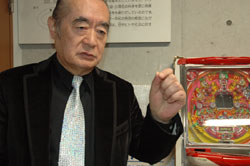 "The benefit of my cement," Nakamats says, pointing at a cross beam above two unclothed mannequins in his office, "is that the particles are small, which enables the beams to be thinner and stronger than usual concrete."
"The benefit of my cement," Nakamats says, pointing at a cross beam above two unclothed mannequins in his office, "is that the particles are small, which enables the beams to be thinner and stronger than usual concrete."
A stroll through the premises reveals a maze of hallways and rooms; some floors are painted green, some walls are red. In his office area, folders and assorted gadgetry are piled high on nearly every table, exposed piping runs the length of the ceilings and multiple human skeletons are on display along the walls — all of which creates the stereotypical environment of the mad scientist at work.
Though not open to the public, Nakamats makes use of multiple specialty spaces as a part of his daily regimen: a home theater that is equipped with a wall-size projection screen and heat-radiating floor tiles that are resistant to cracking; a "calm room" is adorned in gold furnishings for blocking out radio waves that are harmful to the thought process; and a loungelike "dynamic room" is used for creating ideas.
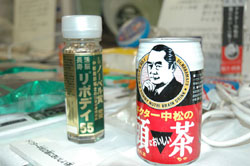 But swallowing each claim by Nakamats with complete confidence is much more difficult than downing a mouthful of the inventor's Brain Drink, which is composed of 13 herbs and is alleged to increase smarts and longevity. A check of a few realtor Web pages shows that many of the 25-sq.-meter guest rooms inside Dr. Nakamats House are available for rent to absolutely anyone willing to pay roughly 100,000 yen per month and the Japanese standard two months' key money and deposit. Also, the Japan Patent Office in 2005 rejected an application for the sidewall energy antenna on the grounds that it is "common knowledge" among scientists in the field. And if it were even possible in the first place, such a revolutionary device would certainly be garnering interest from other parties beyond simply TEPCO.
But swallowing each claim by Nakamats with complete confidence is much more difficult than downing a mouthful of the inventor's Brain Drink, which is composed of 13 herbs and is alleged to increase smarts and longevity. A check of a few realtor Web pages shows that many of the 25-sq.-meter guest rooms inside Dr. Nakamats House are available for rent to absolutely anyone willing to pay roughly 100,000 yen per month and the Japanese standard two months' key money and deposit. Also, the Japan Patent Office in 2005 rejected an application for the sidewall energy antenna on the grounds that it is "common knowledge" among scientists in the field. And if it were even possible in the first place, such a revolutionary device would certainly be garnering interest from other parties beyond simply TEPCO.
Whether he is shooting straight or not, Nakamats has without question had an impact. In 2005, he won an Ig Nobel Prize, a parody of the Nobel Prize, for his practice of photographing each meal he has eaten since the age of 42, the year he believes is the start of one's downward slide in life.
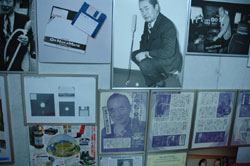 "To win an Ig Nobel Prize, one must do something that first makes people laugh, then makes them think," said Marc Abrahams, cofounder of the Annals of Improbable Research, the organizing body of the Ig Nobel awards. "Dr. Nakamats' epic meal photography work does both those things — and does them with style."
"To win an Ig Nobel Prize, one must do something that first makes people laugh, then makes them think," said Marc Abrahams, cofounder of the Annals of Improbable Research, the organizing body of the Ig Nobel awards. "Dr. Nakamats' epic meal photography work does both those things — and does them with style."
The reasoning behind the photographs can be found in "Rebody," one of the dozens of books authored by Nakamats that details the means for living a healthy life until his projected age of 144.
"I was curious about how I could extend my life span," Nakamats says of his research. "I found that we are eating too much. That is what makes life short."
He concluded that one meal per day is ideal, and that meal itself should be low in oil and around 700 calories. For drinking, coffee should be avoided as it is bad for the brain. The number of sleeping hours should be limited to six, and he encourages a steady intake of Rebody 55, a dietary supplement (10,000 yen for five bottles) of his own invention composed of 55 grains and other elements that is perfect for sprinkling on soup or cereal.
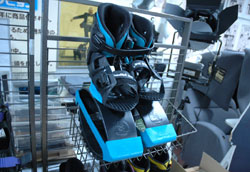 In the Dr. Nakamats Library, whose entry door is written in the typical font found on his products that renders the "N" similar to a lightning bolt, the glory of Nakamats comes to life. Samples of Flying Shoes, strap-on plastic attachments for the feet whose springlike behavior results in minimal strain on the body while running, a pachinko machine that shoots balls automatically and the Dr. Nakamats Cerebrex chair, whose electrical current is said to relieve jet lag and improve eyesight after a 20-minute session, can be found mixed in with letters from dignitaries and accolades from overseas universities. A photo of his first invention, at the age of 5, which included modifications to a model airplane, is posted outside.
In the Dr. Nakamats Library, whose entry door is written in the typical font found on his products that renders the "N" similar to a lightning bolt, the glory of Nakamats comes to life. Samples of Flying Shoes, strap-on plastic attachments for the feet whose springlike behavior results in minimal strain on the body while running, a pachinko machine that shoots balls automatically and the Dr. Nakamats Cerebrex chair, whose electrical current is said to relieve jet lag and improve eyesight after a 20-minute session, can be found mixed in with letters from dignitaries and accolades from overseas universities. A photo of his first invention, at the age of 5, which included modifications to a model airplane, is posted outside.
Also exhibited is the evolution of his most recognized work, the floppy disk. "I was in my second year at the University of Tokyo Engineering Department," he remembers of the floppy's beginnings. "Back then I really liked to listen to Beethoven's Symphony No. 5. But I thought the combination of the relatively fast-spinning 78 rpm record, the grinding of the groove with the needle and scratches on the record produced an unclear sound."
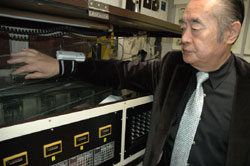 Nakamats subsequently, in 1952, patented a floppy media and data reader that would eventually result in a series of licensing agreements with IBM Corp. in 1979. Though many experts have questioned Nakamats' claim as the inventor, Nakamats and a representative from IBM wished to not comment on the details of their agreement. However, Nakamats, who is reluctant to divulge earnings figures for this or any of his works, adamantly maintains that he is indeed the father of the floppy.
Nakamats subsequently, in 1952, patented a floppy media and data reader that would eventually result in a series of licensing agreements with IBM Corp. in 1979. Though many experts have questioned Nakamats' claim as the inventor, Nakamats and a representative from IBM wished to not comment on the details of their agreement. However, Nakamats, who is reluctant to divulge earnings figures for this or any of his works, adamantly maintains that he is indeed the father of the floppy.
Still, the life of a successful innovator is not always smooth. At the aforementioned news conference, Nakamats also presented the Dr. Nakamats Grip (7,800 yen), a bulky rubber golf putting grip that allows the user to align his thumbs in parallel down the shaft and, according to its inventor, achieve better control of the ball. The grip was already in existence as a part of a complete putter he patented in 1980. But Nakamats has recently found that grip company Golf Pride is now marketing a similar parallel-thumb model, which he claims is infringing on his patent.
Much of what drives Nakamats are the fond memories he has of his mother. At the age of 14, he went to the library and studied Bernoulli's principle, which provides a relationship between the velocity and pressure of a moving fluid, to assist his mother in cooking with shoyu (soy sauce). The result eventually became the home kerosene pump. "It was 1943," he remembers, "there was no fuel during the war. So it was very cold. My mother was working in the kitchen. It was difficult to pour a bottle of soy sauce with her shaking hand. I was looking at her, and I wanted to help."
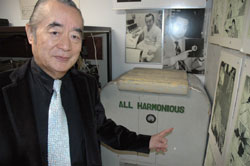 Though he is said to charge upward of 1 million yen an hour for public speaking, Nakamats maintains that money is in no way his driving force and that he funds all the research for his projects independently. In fact, recent years have seen him focus his attention on less tangible topics that he thinks can have a more positive impact on the world.
Though he is said to charge upward of 1 million yen an hour for public speaking, Nakamats maintains that money is in no way his driving force and that he funds all the research for his projects independently. In fact, recent years have seen him focus his attention on less tangible topics that he thinks can have a more positive impact on the world.
Last year, he made his fourth unsuccessful attempt at being elected governor of Tokyo, collecting nearly 86,000 votes — the highest for any independent candidate. He feels that his holistic approach to tackling an invention is perfectly suitable for addressing society's ills as a politician, and make no mistake, he will be running again.
Though his future direction is not certain — toward public office or otherwise — perhaps the guiding philosophy within the world of Nakamats is best conveyed through the lyrics of the "Dr. Nakamats Song," his personal theme tune, which can be summed up as: Make an effort, invent and enjoy; think and create like magic.
And no, he doesn't have a patent on magic yet. But give him time.
Note: This story originally appeared in the January 9th issue of The Japan Times. Dr. Nakamats can be found on the Web at http://nakamats.com/.
The Inventor Series > Dr. Nakamats > Thanko > Maywa Denki

